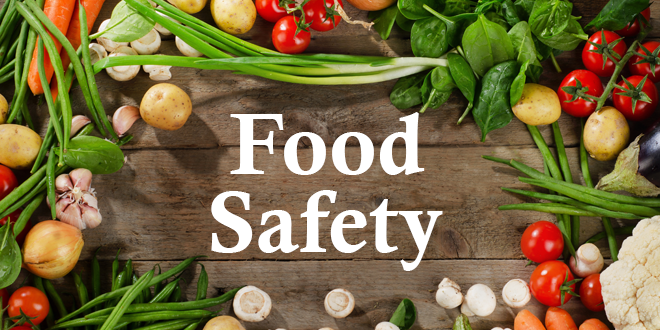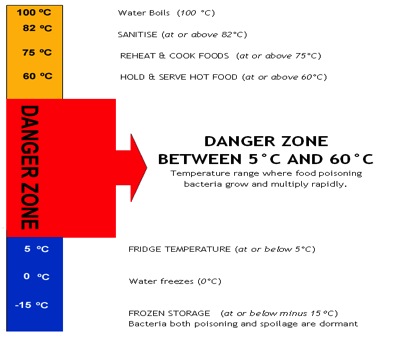Food Safety & Hygiene
Basics for Handling Food Safely
- Shopping
- Storage
- Preparation
- Thawing
- Cooking
- Serving
- Leftovers
- Refreezing
- Cold Storage Chart
Safe steps in food handling, cooking, and storage are essential to prevent foodborne illness. You can’t see, smell, or taste harmful bacteria that may cause illness. In every step of food preparation, follow the four steps of the Food Safe Families campaign to keep food safe:
- Clean — Wash hands and surfaces often.
- Separate — Don’t cross-contaminate.
- Cook — Cook to the right temperature.
- Chill — Refrigerate promptly.
Shopping
- Purchase refrigerated or frozen items after selecting your non-perishables.
- Never choose meat or poultry in packaging that is torn or leaking.
- Do not buy food past “Sell-By,” “Use-By,” or other expiration dates.
Storage
- Always refrigerate perishable food within 2 hours—1 hour when the temperature is above 90 °F (32.2 ºC).
- Check the temperature of your refrigerator and freezer with an appliance thermometer. The refrigerator should be at 40 °F (4.4 ºC) or below and the freezer at 0 °F (-17.7 ºC) or below.
- Cook or freeze fresh poultry, fish, ground meats, and variety meats within 2 days; other beef, veal, lamb, or pork, within 3 to 5 days.
- Perishable food such as meat and poultry should be wrapped securely to maintain quality and to prevent meat juices from getting onto other food.
- To maintain quality when freezing meat and poultry in its original package, wrap the package again with foil or plastic wrap that is recommended for the freezer.
- Canned foods are safe indefinitely as long as they are not exposed to freezing temperatures, or temperatures above 90 °F. If the cans look ok, they are safe to use. Discard cans that are dented, rusted, or swollen. High-acid canned food (tomatoes, fruits) will keep their best quality for 12 to 18 months; low-acid canned food (meats, vegetables) for 2 to 5 years.
Preparation
- Always wash hands with warm water and soap for 20 seconds before and after handling food.
- Don’t cross-contaminate. Keep raw meat, poultry, fish, and their juices away from other food. After cutting raw meats, wash cutting board, utensils, and countertops with hot, soapy water.
- Cutting boards, utensils, and countertops can be sanitized by using a solution of 1 tablespoon of unscented, liquid chlorine bleach in 1 gallon of water.
- Marinate meat and poultry in a covered dish in the refrigerator.
Thawing
- Refrigerator: The refrigerator allows slow, safe thawing. Make sure thawing meat and poultry juices do not drip onto other food.
- Cold Water: For faster thawing, place food in a leak-proof plastic bag. Submerge in cold tap water. Change the water every 30 minutes. Cook immediately after thawing.
- Microwave: Cook meat and poultry immediately after microwave thawing.
Cooking
Cook all raw beef, pork, lamb and veal steaks, chops, and roasts to a minimum internal temperature of 145 °F (62.8 ºC) as measured with a food thermometer before removing meat from the heat source. For safety and quality, allow meat to rest for at least three minutes before carving or consuming. For reasons of personal preference, consumers may choose to cook meat to higher temperatures.
Ground meats: Cook all raw ground beef, pork, lamb, and veal to an internal temperature of 160 °F (71.1 ºC) as measured with a food thermometer.
Poultry: Cook all poultry to an internal temperature of 165 °F (73.9 °C) as measured with a food thermometer.
- Hot food should be held at 140 °F (60 °C) or warmer.
- Cold food should be held at 40 °F (4.4 ºC) or colder.
- When serving food at a buffet, keep food hot with chafing dishes, slow cookers, and warming trays. Keep food cold by nesting dishes in bowls of ice or use small serving trays and replace them often.
- Perishable food should not be left out more than 2 hours at room temperature—1 hour when the temperature is above 90 °F (32.2 ºC).
What is Danger Zone in Food Safety?
The Danger Zone is the temperature range between 40 °F (4.4 ºC) and 140 °F (60 ºC) in which bacteria can grow rapidly.To keep food out of the Danger Zone, keep cold food cold, at or below 40 °F (4.4 ºC) , and hot food hot, at or above 140 °F (60 ºC).
Keep cold food in the refrigerator, in coolers, or in containers on ice. Keep hot cooked food in the oven, in heated chafing dishes, or in preheated steam tables, warming trays and/or slow cookers. Use a food thermometer to verify temperatures. Never leave food in the Danger Zone over 2 hours; 1 hour if outside temperature is above 90 °F (32.2 ºC) .
Leftover
- Discard any food left out at room temperature for more than 2 hours—1 hour if the temperature was above 90 °F (32.2 ºC).
- Place food into shallow containers and immediately put in the refrigerator or freezer for rapid cooling.
- Use cooked leftovers within 4 days.
- Reheat leftovers to 165 °F (73.9 °C).
Refreezing
Meat and poultry defrosted in the refrigerator may be refrozen before or after cooking. If thawed by other methods, cook before refreezing.
Cold Storage Chart
These short, but safe, time limits will help keep refrigerated food from spoiling or becoming dangerous to eat. Because freezing keeps food safe indefinitely, recommended storage times are for quality only.
| Cold Storage Chart | ||||
|---|---|---|---|---|
| Product | Refrigerator 40 °F (4.4 ºC) |
Freezer 0 °F (-17.7 ºC) |
||
| Eggs | ||||
| Fresh, in shell | 3 to 5 weeks | Do not freeze | ||
| Raw yolks & whites | 2 to 4 days | 1 year | ||
| Hard cooked | 1 week | Does not freeze well | ||
| Liquid pasteurized eggs, egg substitutes | ||||
| Opened | 3 days | Does not freeze well | ||
| Unopened | 10 days | 1 year | ||
| Mayonnaise, Commercial | ||||
Refrigerate after opening |
2 months | Do not freeze | ||
| Frozen Dinners & Entrees | ||||
| Keep frozen until ready to heat | — | 3 to 4 months | ||
| Deli & Vacuum-Packed Products | ||||
| Store-prepared (or homemade) egg, chicken, ham, tuna, & macaroni salads | 3 to 5 days | Does not freeze well | ||
| Hot dogs & Luncheon Meats | ||||
| Hot dogs | ||||
| Opened package | 1 week | 1 to 2 months | ||
| Unopened package | 2 weeks | 1 to 2 months | ||
| Luncheon meat | ||||
| Opened package | 3 to 5 days | 1 to 2 months | ||
| Unopened package | 2 weeks | 1 to 2 months | ||
| Bacon & Sausage | ||||
| Bacon | 7 days | 1 month | ||
| Sausage, raw — from chicken, turkey, pork, beef | 1 to 2 days | 1 to 2 months | ||
| Smoked breakfast links, patties | 7 days | 1 to 2 months | ||
| Hard sausage — pepperoni, jerky sticks | 2 to 3 weeks | 1 to 2 months | ||
| Summer sausage labeled “Keep Refrigerated” |
||||
| Opened | 3 weeks | 1 to 2 months | ||
| Unopened | 3 months | 1 to 2 months | ||
| Corned Beef | ||||
| Corned beef, in pouch with pickling juices | 5 to 7 days | Drained, 1 month | ||
| Ham, canned labeled “Keep Refrigerated” |
||||
| Opened | 3 to 5 days | 1 to 2 months | ||
| Unopened | 6 to 9 months | Do not freeze | ||
| Ham, fully cooked | ||||
| Vacuum sealed at plant, undated, unopened | 2 weeks | 1 to 2 months | ||
| Vacuum sealed at plant, dated, unopened | “Use-By” date on package | 1 to 2 months | ||
| Whole | 7 days | 1 to 2 months | ||
| Half | 3 to 5 days | 1 to 2 months | ||
| Slices | 3 to 4 days | 1 to 2 months | ||
| Hamburger, Ground & Stew Meat | ||||
| Hamburger & stew meat | 1 to 2 days | 3 to 4 months | ||
| Ground turkey, veal, pork, lamb, & mixtures of them | 1 to 2 days | 3 to 4 months | ||
| Fresh Beef, Veal, Lamb, Pork | ||||
| Steaks | 3 to 5 days | 6 to 12 months | ||
| Chops | 3 to 5 days | 4 to 6 months | ||
| Roasts | 3 to 5 days | 4 to 12 months | ||
| Variety meats — tongue, liver, heart, kidneys, chitterlings | 1 to 2 days | 3 to 4 months | ||
| Pre-stuffed, uncooked pork chops, lamb chops, or chicken breasts stuffed with dressing | 1 day | Does not freeze well | ||
| Soups & Stews Vegetable or meat added |
3 to 4 days | 2 to 3 months | ||
| Fresh Poultry | ||||
| Chicken or turkey, whole | 1 to 2 days | 1 year | ||
| Chicken or turkey, pieces | 1 to 2 days | 9 months | ||
| Giblets | 1 to 2 days | 3 to 4 months | ||
| Cooked Meat and Poultry Leftovers | ||||
| Cooked meat & meat casseroles | 3 to 4 days | 2 to 3 months | ||
| Gravy & meat broth | 3 to 4 days | 2 to 3 months | ||
| Fried chicken | 3 to 4 days | 4 months | ||
| Cooked poultry casseroles | 3 to 4 days | 4 to 6 months | ||
| Poultry pieces, plain | 3 to 4 days | 4 months | ||
| Poultry pieces in broth, gravy | 3 to 4 days | 6 months | ||
| Chicken nuggets, patties | 3 to 4 days | 1 to 3 months | ||
| Other Cooked Leftovers | ||||
| Pizza, cooked | 3 to 4 days | 1 to 2 months | ||
| Stuffing, cooked | 3 to 4 days | 1 month | ||
Copyright © 2018 Hasnain Zaki. All Rights Reserved.














